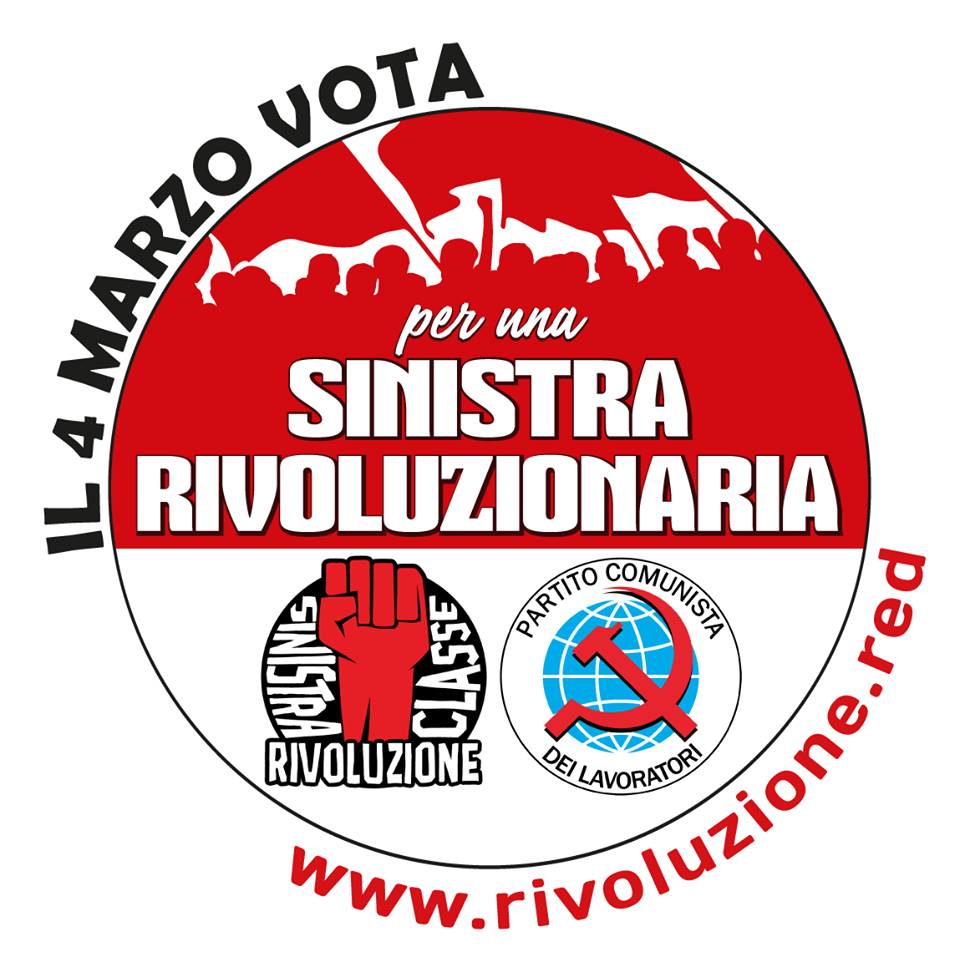Italy goes to the polls on 4 March in the context of economic crisis and a general impasse in the political situation. It seems likely that the elections will produce a hung parliament with no outright winner. The right wing will emerge strengthened, but also the Five Stars Movement will most likely be the strongest single party. And what remains of the left has all but collapsed. The most striking feature is the generalised disgust of the masses with all the old established parties. In these conditions the Italian comrades of the IMT decided to stand their own independent list.
Find out more about the Italian comrades' election campaign at Rivoluzione. Also on Facebook, @scrivoluzioneivoluzione.
Economic and social crisis
In order to understand the most recent developments in the Italian political situation, it is necessary to look at both the economic and political background that has created the present impasse. Italy is the third largest economy in the Eurozone and the eighth largest in the world in terms of GDP, but it was hit hard by the 2008-09 crisis, suffering a 9 percent overall drop of its GDP between 2008 and 2013, and in spite of the subsequent so-called 'recovery' of around 1 percent, it has in fact been stagnating.
Workers’ hourly wages in Italy in the five year period of 2012-16 grew by an annual average of only 0.8 percent, consistently falling behind inflation, hitting rock bottom in 2016 at a mere 0.2 percent. Many industrial workers are on around €1100 to €1200 a month (€13-14,000 a year), and young workers can be earning much less. In the south many young people are on jobs of around €500 a month. Meanwhile, the top 20 percent earn almost six times as much as the bottom 20 percent!
Italian workers’ wages have been whittled down over a long period as a result of years of anti-worker legislation. Italy’s Ministry for Economic Development boasts that, “Italian hourly labour costs are below the Eurozone average” in its attempt to attract investment. However, Italy lags way behind its main competitors in terms of productivity, which actually fell in 2016, and is expected to continue to be low for some years to come. This is due to the chronically low levels of investment by Italian capitalists who prefer to either invest abroad or make money from speculation.
Many jobs have been destroyed in the same period. Unemployment is around 11 percent, but among the youth it is much higher, standing at third highest in the European Union at 32.2 percent, with only Greece and Spain having higher levels. If we look at the 'active youth', that is to say excluding students and so on, the figure is actually above 40 percent, of which half are long term unemployed. Among those classed as employed, many are working part-time or on temporary contracts. This is thanks to the new labour laws recently introduced, which render the labour market very 'flexible'. There is also the disparity between the North and the South. For example, in the southern region of Calabria in 2016 youth unemployment stood at 58.7 percent: the highest regional youth unemployment in Europe! These figures reveal the dramatic situation facing Italian youth.
In 2015 poverty levels reached a 10-year high. Around 8 percent of the population is now living in what is classed as 'absolute poverty' (people who cannot afford even basic needs to survive), while a further 14 percent are living in relative poverty, meaning those on less than half the national average income. One third of children are at risk of falling into poverty. For the first time, 18-34 year olds are appearing in reports as the age group most affected by poverty.
There is a never-ending onslaught on welfare, with cuts in healthcare, education, pensions and public spending in general. All this has been in the name of balancing the books, of reducing the public debt. But the public debt shot up from 120 percent of GDP in 2008 to over 133 percent now, standing at a total of €2.2 trillion.
Austerity, as in other countries, is not working. While spending on services has been cut, billions have been handed over to the banks in crisis, and billions more have gone into paying the interest on the accumulated debt. Between 2007 and 2016 interest payments on the debt amounted to a total of €760 billion, equal to one third of the present overall debt! For every €20 of GDP produced, €1 goes on servicing the debt, which is more than is spent on running the education system! Spending on essential services, education, healthcare, pensions and so on is cut but the debt keeps ballooning.
All this is making life for ordinary working people very hard. In these conditions it is not surprising that Italy’s young – and not so young – are emigrating in large numbers. In 2015 alone over 100,000 Italians left the country to seek work abroad and the numbers keep growing.
Disillusionment with the establishment
Since the collapse of the old party system in 1992-94, Italy has been governed by alternating centre-left and centre-right coalitions.
On the right there was the creation of new parties and transformations of the old. The old MSI (Movimento Sociale Italiano), which was a survival of the old fascist party in a recycled form, changed its name and moved towards being a more classical right-wing conservative party, Alleanza Nazionale, later splitting and fragmenting as a result of its participation in government. At the same time Berlusconi launched his Forza Italia party in order to fill the vacuum left by the collapse of the Christian Democracy. And in the North we saw the emergence of the Northern League, an openly racist and xenophobic party, initially campaigning on the idea of the need for the north to separate from the rest of the country. Its propaganda was openly insulting to southern Italians. Realising that to become an important player in Italian politics, more recently it dropped its anti-South demagogy, changed its name to simply the Lega (League) and shifted everything towards a rabid anti-immigrant stance.
On the left, the old Communist Party split in 1991, with the majority adopting the name PDS, ‘Democratic Party of the Left’, and the minority giving birth to the PRC, the ‘Party of Communist Refoundation’. There were also a number of smaller parties, such as the Greens, fragments of the old Christian Democracy and so on, who would coalesce with the PDS as the 'centre-left'.
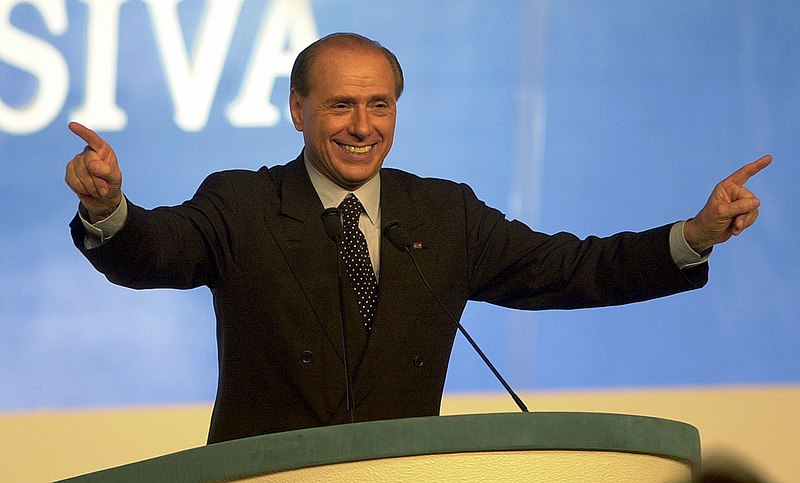 Over a 25-year period successive governments have systematically dismantled the old welfare state / Image: alessio85
Over a 25-year period successive governments have systematically dismantled the old welfare state / Image: alessio85
The centre-right, led by Berlusconi, governed Italy in 1994-95, followed by centre-left governments until 2001. The PRC gave external support to Prodi’s centre-left government of 1996-98, splitting when in 1998 it decided not to support the next incoming centre-left government. Between 2001 and 2006 Berlusconi’s centre-right returned to office again, followed by two years of the centre-left in government, 2006-08, when the PRC leadership, not having learnt anything from its previous experience with Prodi, actually joined the government with ministerial positions. This time the PRC was to suffer a heavy blow, losing all its MPs in 2008 when Berlusconi made another comeback, governing the country until 2011. Such was the depth of the crisis in 2011 that the Italian ruling class manoeuvred into position a 'technocratic government' led by the ex-banker Mario Monti. This was a de facto coalition between the Democratic Party and Berlusconi who both offered parliamentary support to Monti. And since 2013 Italy has been governed by the Democratic Party.
Throughout this 25-year period successive governments have systematically dismantled much of the old welfare state, with attacks on pensions, cuts in healthcare and education spending, and a series of laws that have made it easier to sack workers and introduced more and more casualisation of labour, destroying most of what the Italian working class had fought hard for in the post-war period.
All this alternating of centre-right and centre-left governments, combined with a constant worsening of living conditions for the mass of working people, gradually whittled away the confidence of the masses in the established parties. On the left the PRC collapsed as a consequence of its participation in the centre-left government carrying out austerity. The PDS completed its transformation into an openly bourgeois party. In fact, it is the genuine expression of the Italian ruling class, with Renzi being seen as the loyal servant of the capitalist class.
Added to all this are the numerous corruption scandals that keep erupting, involving MPs from practically all the old established parties. Let us not forget that in the period 1991-93 the old political system collapsed, with the Christian Democrats and Socialist Party so immersed in the scandals of that period that they disappeared from the political scene. Since then practically all the main parties have been involved in some scandal or other. Thus, disillusionment with politicians in general has been building up over a long period.
Meanwhile, on the trade union front, the leaders have been selling out over and over again. Most of the conquests won by the workers in bitter struggles in the 1960s and 1970s have been whittled away. The labour laws have been changed, making it far easier to sack workers. Many of the things which in the past were considered illegal, have now been legalised, such as the zero hour contracts, short-term contracts and so on. This has left the workers with a sense that no one is defending them, neither on the political front, nor on the trade union front. Where any struggles have taken place, these are usually initiatives that come from the rank and file overriding the trade union bureaucracy or from a number of small unions that have broken away from the official unions.
In these conditions, the number of people deciding not to take part in elections began to grow. In the 1970s voter participation was over 90 percent, but this has gone down gradually over the years, falling to just over 70 percent in 2013. Since then, in a series of regional and local elections participation has been even lower at little over 50 percent and in some cases falling below that figure.
The emergence of the Five Stars Movement
It is in these conditions that in 2009 the comedian Beppe Grillo launched his Five Stars Movement (Movimento Cinque Stelle, M5S) online, receiving massive support. In the 2013 elections the M5S stood for the first time in the general election and was the most-voted party, although because it stood on its own, refusing to form an electoral coalition with any other party, it only won 109 deputies out of 630 that make up the parliament. Nonetheless it was a political shock. Last year the M5S won the mayoral elections in two major cities, Turin and Rome.
How can one characterise this new party? It emerged as a force in a period which saw Melenchon launch his Left Party in France, later to shift to La France Insoumise, Podemos being launched as a major opposition force in Spain, and Syriza being catapulted from being a marginal left party in Greece to a party of government. A superficial observer could easily make the mistake of thinking that the M5S is similar to the above phenomena, but that would be a big mistake. Melenchon, Podemos and Syriza all grew on the back of huge social movements, massive strikes and protests, and are expressions of those movements.
In Italy this was not the case. What we had was a huge disillusionment with the old parties, widespread anger about the attacks on working people, but no real outlet for this anger on the trade union or political front. At the same time, the old official left had either collapsed or metamorphosed into the bourgeois Democratic Party. The only credible force on the left had been Rifondazione Comunista, but after first supporting and then participating in centre-left governments, as we have seen above, the party fragmented and was reduced to an insignificant force, with no MPs or Senators.
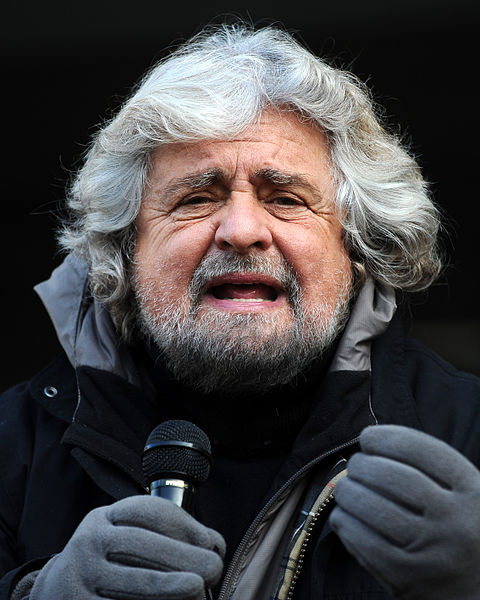
In this vacuum, the anti-corruption demagogy of Grillo and his M5S movement got an echo among a wide layer of the population. The real mood in the country is one of 'kick them all out', and the M5S gives expression to this feeling. But the M5S is not a left party, it is not a workers’ party. Many left-wing people vote for it, many former Communist Party voters support it, but it is not an organisation of the working class. In fact, it has attracted people from both the left and the right and it can be described as bourgeois populist. It does not challenge in any way the capitalist system. It makes a lot of noise about fighting corruption and cleaning things up. However, once they get into office they reveal all their weaknesses. They are presently running Rome and Turin and nothing fundamental has changed. The reasons for this is that they are not prepared to take on the capitalists, they do not question the essential nature of capitalism, and wish to play according to the laws of the 'market economy'. This means that where they win office, they have to run the system according to the rules that govern it. Therefore, debts have to be paid, interest on their debts need to be paid, and so on.
In the recent period, the nature of the M5S has become even clearer. As the prospect of it becoming a force of government has become real, it has shifted further and further to the right. Its present leader, Luigi Di Maio, considered the leader of the more moderate faction of the M5S, has been busy reassuring the Italian capitalists with public statements about how pro-business he and the party he leads are. In September, when he attended a conference of the Confindustria, the Italian bosses’ union, he announced that his model was Rajoy’s government in Spain! He also made it clear that they were dropping their anti-EU stance, further soothing the nerves of the bosses, and then made a trip to the United States to reassure the US ruling class, followed by a visit to the Vatican and overtures to Macron in France. The M5S has also adopted an anti-immigrant policy and has come out with a clear anti-trade union position.
Fascist activities
It is also worth dedicating a few lines to the activities of the openly Fascist organisations in Italy in this context, Forza Nuova and Casa Pound. They have been trying to tap into the present mood of general disgust towards the old parties. They try to present themselves as the 'original' fascists, harking back to the 1919 foundation of Mussolini’s Fascist Party, when he tried to portray an image of being both anti-capitalist and anti-communist.
These organisations are contributing to whipping up a mood of racist hysteria among certain layers of the population, organising physical attacks on immigrants, exploiting the presence of a growing number of immigrants in the recent period. This is also aided and abetted by the leaders of the right-wing parties in parliament, who constantly call for the repatriation of immigrants and to tighten up border controls. Forza Nuova are also openly homophobic and are opposed to abortion rights.
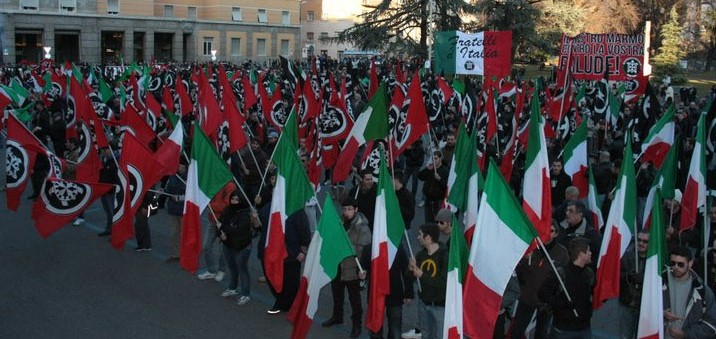 Fascist groups like Forza Nuova and Casa Pound have been trying to tap into the mood of disgust towards the old parties / Image: PD Utente
Fascist groups like Forza Nuova and Casa Pound have been trying to tap into the mood of disgust towards the old parties / Image: PD Utente
In this context on 3 February, in the town of Macerata, 28-year old Luca Traini drove through the streets with a firearm and opened fire on anyone who looked like an African immigrant, injuring six of them, and then, with the Italian flag draped around his shoulders, and made the fascist salute before being arrested by the police. Although Casa Pound distanced itself from the action, as it is attempting to clean up its act and appear as a more reasonable right-wing force – in 2011 a Casa Pound sympathiser, in fact, killed two African immigrants in Florence – Forza Nuova immediately came out in support of Traini and has offered to provide lawyers for his defence.
The Lega and Berlusconi, instead of openly condemning the shooting, came out with statements putting the blame on immigration, hinting at the fact that such actions are “understandable”.
All this has provoked the indignation of many workers and youth around the country with demonstrations of tens of thousands in several cities up and down the country. These events highlight the tense situation that exists in Italy, but also show that there is a very radicalised layer on the left that wants to do something to fight the right wing.
The impasse on the left
The existence of the M5S represents a huge obstacle to the development of a mass force on the left. It has captured the vote of many left wingers and, in spite of everything said above, it has still not been put to the test in government. All the other parties are so rotten, that up to 30 percent of the electorate will be voting for it in the 4 March elections, with 40-43 percent of the youth supporting them.
This obstacle will only be removed by major events. It could be tested in government at some point and that would expose all its limitations to those who presently still have big illusions. But also in opposition, as it is forced to become a more 'responsible' party by the ruling class, its actions can begin to weaken it social base as the crisis deepens further. In a certain sense, one can say that this process has already begun. In the 2013 election campaign the M5S could fill squares with tens of thousands of enthusiastic supporters. That is no longer the case, as their campaign is of a much more passive character. The illusions placed in it are huge, and once it is exposed, it will be weakened and could fragment and collapse, opening up room for something to develop on the left. But for now it stands there, like a near-immovable mountain.
The situation of the left is disastrous. The Democratic Party has seen a process in which Renzi, the direct representative of the bourgeoisie, has taken full control of the party. The bureaucrats that originated in the old Communist Party have been gradually elbowed to one side, and this has led to a series of splits of groups of MPs out to defend their parliamentary positions. These are now gathered in the Liberi e Uguali (Free and Equal) electoral list. This list is made up of politicians who backed the anti-worker legislation of the centre-left governments in the past and are not seen as a clear alternative. One of its leaders is Massimo D’Alema, who was premier in the 1998-2000 centre-left government and quite a hated figure on the left. This explains why the opinion polls put them on about 6 percent in the forthcoming elections. At the moment Free and Equal has not become a party with an active membership, but is simply a parliamentary coalition of ex-Democratic Party MPs out to preserve their careers. They have stated that after the elections they intend to form a party, and this could be the basis of the emergence of a Social Democratic formation, which has the support of the CGIL bureaucracy. Only the future will tell how this formation will develop.
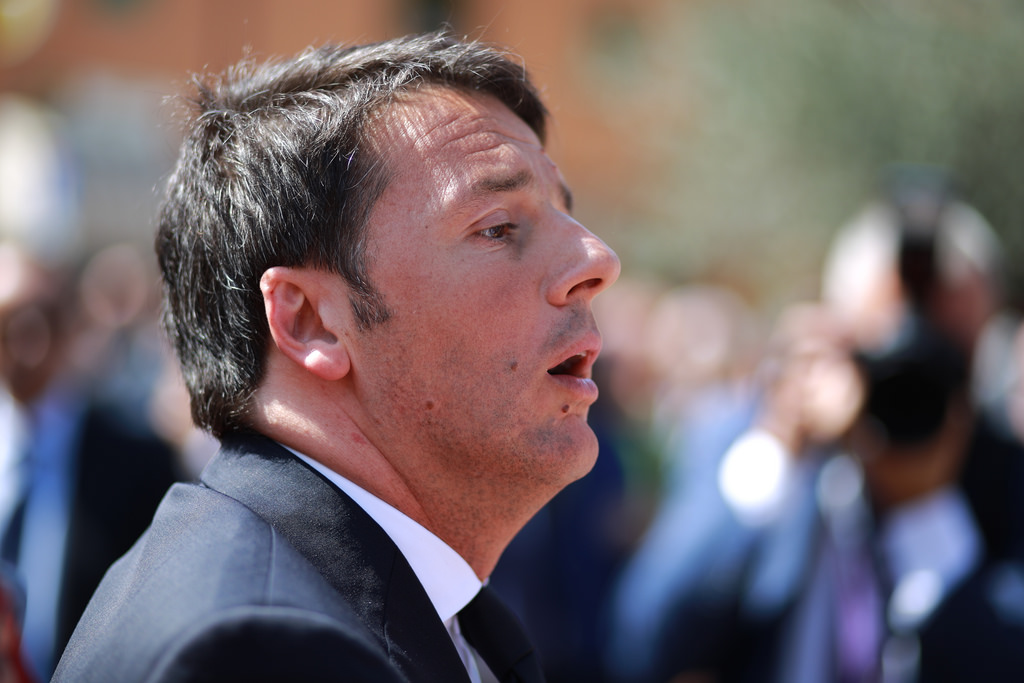 Public trust in politicians is at rock bottom / Image: Francesco Plerantoni
Public trust in politicians is at rock bottom / Image: Francesco Plerantoni
Opinion polls indicate that the right-wing, a coalition of four parties, will emerge as the strongest electoral coalition, although without an outright majority. The M5S will be the biggest single party and the Democratic Party, in coalition with a number of smaller parties, will see its vote significantly reduced. Free and Equal will get into parliament with a small group of MPs on around 6 percent, above the 3 percent threshold. Whatever is left would be shared out between the far-right fascist formations and the far-left.
In this context, the leaders of what is left of Rifondazione Comunista has coalesced with other left groups to launch Potere al Popolo (Power to the People). Rifondazione itself has been reduced to a sect with a few thousand members. Long gone are the days when it had over 120,000 members and a sizeable group in parliament. The opinion polls indicate this list could win around 0.9 percent. This grouping has all the disadvantages of being made up of leaders who have participated in centre-left governments in the past, voting its anti-worker policies but without the advantage of mass support. Their active base is no more than 3000 to 5000 around the country. They also continue to support Tsipras in Greece, conveniently ignoring his anti-worker policies over the last two years. There is also a small group called the Partito Comunista, led by Marco Rizzo, also a former leader of Rifondazione, now linked to the Greek KKE, but which presently is expected to get around 0.2 percent in the elections.
What should the Marxists do?
The comrades of the IMT in Italy worked for around 20 years in Rifondazione Comunista. They were part of the left-wing of the party, with members on the Central Committee, on the Executive and, for a short period, also on the Central Secretariat. They fought for the party to adopt a genuine Marxist policy. They opposed the party’s participation in and support for centre-left governments. They patiently explained that such a policy would be disastrous for the party. Eventually they were proved correct but found themselves in a party which was rapidly haemorrhaging both members and electoral support.
In 2008, after the disastrous election result, the Marxists had helped to defeat the old right-wing leadership and push the party to the left (at the Chianciano conference), but the party leadership very quickly swung back to the right. In these conditions, the Italian IMT comrades discussed the need to adopt a more open stance in their work. The workers and youth no longer saw Rifondazione as a point of reference. The youth had no idea that the party even existed!
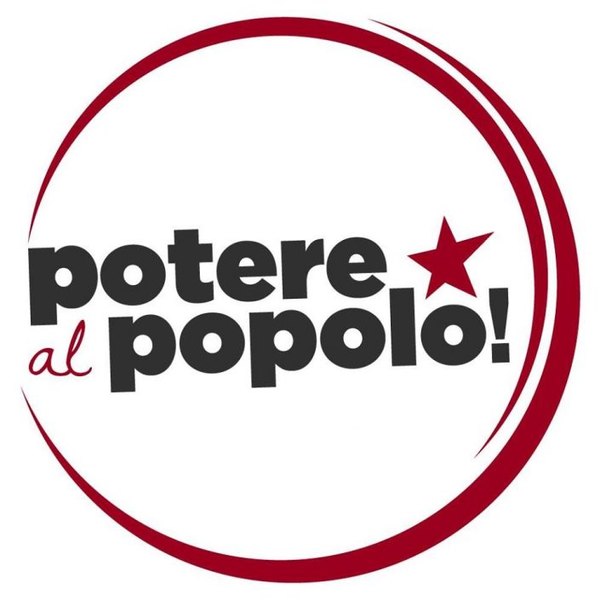 Rifondazione Comunista has coalesced with other left groups to cobble together Power to the People / Image: Doc 95
Rifondazione Comunista has coalesced with other left groups to cobble together Power to the People / Image: Doc 95
In 2013 the comrades decided to present a more open profile. They launched a new political movement, Sinistra Classe Rivoluzione (‘Left-wing, Class and Revolution’) and changed the name of their paper from FalceMartello (‘Hammer and Sickle’) to Rivoluzione (‘Revolution’) and at the beginning of 2016 they officially left Rifondazione. This was a necessary step, as being connected to Rifondazione had become an obstacle to reaching the most advanced workers and youth. Whereas in the past Rifondazione had significant mass support, and to be seen as the Marxist left of the party played a useful role in getting the ideas of revolutionary Marxism an audience, it had now turned into its opposite, becoming a de facto obstacle. The high sales of Rivoluzione indicated that this more open approach was a far better way of getting the ideas to connect with the most advanced elements.
The general election on 4 March this year posed the question of what to do as an open Marxist tendency. The situation facing the Marxists was an anomalous one. There was no party to which they could even consider giving 'very critical' support. The Democratic Party is a hated bourgeois party, Free and Equal are seen as an insignificant force of Democratic Party has-beens and Power to the People is in effect a reformist sect unknown to the masses.
This is what led the Italian IMT comrades to issue an appeal last year to form an electoral list of the revolutionary left. Initially they received interest from Sinistra Anticapitalista (‘Anticapitalist Left’) and the Partito Comunista dei Lavoratori (‘Communist Workers’ Party’). This was before the launching of Power to the People. The leaders of Rifondazione up till then, (November of last year) were desperately trying to be accepted into what became the Free and Equal coalition, but the latter decided they had no need of Rifondazione as it no longer counted for anything electorally. The Rifondazione leaders have one sole aim in mind: to get elected to parliament again, as with this a certain amount of funding is available. Being part of a larger, more credible coalition, they see as the only way of achieving this. Once they were rejected, however, they then worked to launch Power to the People. Once they did this, the more opportunist Anticapitalist Left immediately jumped ship and left the IMT in an alliance with the Communist Workers’ Party.
Massive signature campaign
They decided to call the joint list Sinistra Rivoluzionaria, the Revolutionary Left. But this was only the first step. The latest electoral law in Italy states that any party that is not already in parliament must collect a sizeable number of signatures in support of their list’s right to stand. This was a big task, but they immediately mobilised all their forces. Over a five-week period they set up 500 stalls the length and breadth of Italy and collected 20,000 signatures, speaking to about 100,000 people in the process.
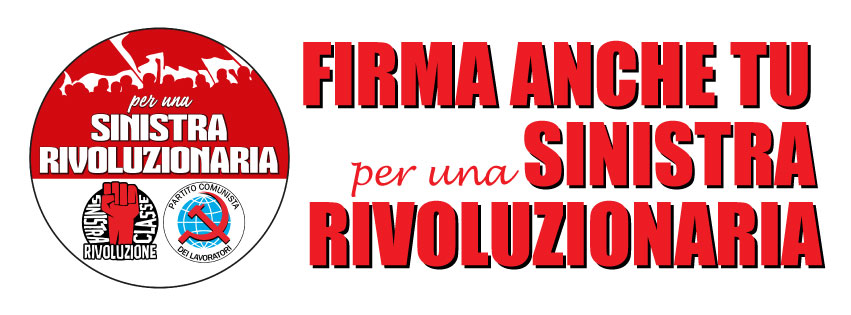 The IMT comrades launched a joint list: Sinistra Rivoluzionaria / Image: own work
The IMT comrades launched a joint list: Sinistra Rivoluzionaria / Image: own work
The mood the comrades encountered was one of a general rejection of politics with people being completely alienated from the political system. However, there was a layer that showed great interest in their ideas. In fact, many people who signed would also buy the paper. They also collected hundreds of names and addresses of people who did not just agree to sign, but also wanted to learn more about the Marxist Tendency.
The Marxists went in front of the factories, on the campuses, outside the high schools, raising the ideas and the programme. In some cases, individual shop stewards in factories offered to collect signatures. In one case, a single shop steward collected 100 signatures in his factory, for example, and in another, at Naples University, 50 signatures were collected at one stall. This shows that there is a layer among the workers and the youth that is looking for answers, that wants to know what can be done to break the logjam on the left in Italy. Only the Marxists can offer answers to this layer.
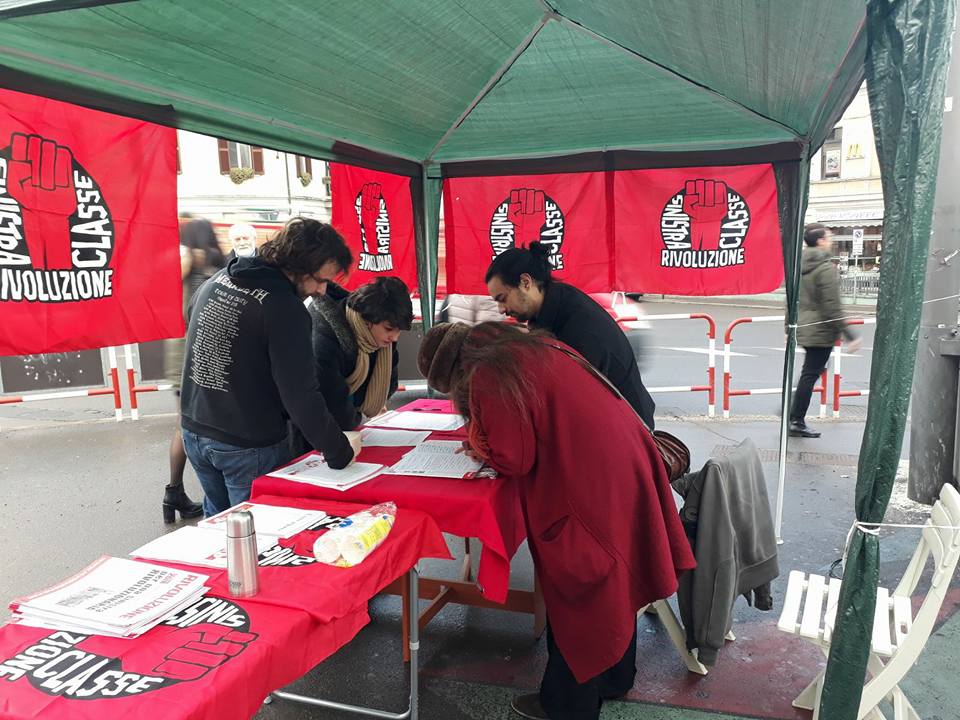 Comrades collected 20,000 signatures, speaking to about 100,000 people / Image: own work
Comrades collected 20,000 signatures, speaking to about 100,000 people / Image: own work
In a period of just a few weeks the whole of the organisation was mobilised. It was not, however, just a case of collecting the signatures and handing them in. The signatures could not be collected just in one area, but had to be spread across several constituencies. And each signature had to be checked in the municipality of residence and the electoral certificate of each signee had to be found. It involved systematically visiting dozens of local municipalities. But in the end they were successful and their list is now on the official ballot papers in 60 percent of the country.
No one has illusions that the Marxists are going to get a massive vote, but that is not what this campaign is about. The aim is to project as widely as possible the profile of the Marxist Tendency, meet potential supporters and new members and strengthen the presence of the Tendency in different parts of the country. There has been a lot of online interest, including from areas where the Tendency was not previously present, and already some of these are getting organised to help build the Marxist Tendency.
Now that the signatures have been collected and officially ratified, and the symbol of the list has been registered, the actual election campaign has begun. Many of the candidates on the list have been interviewed in local TV stations; articles mentioning the list have appeared in several papers; and there have also been interviews on national TV. Simply by being on the ballot paper means that around 20 million voters will see the symbol and be made aware of the existence of the Revolutionary Left.
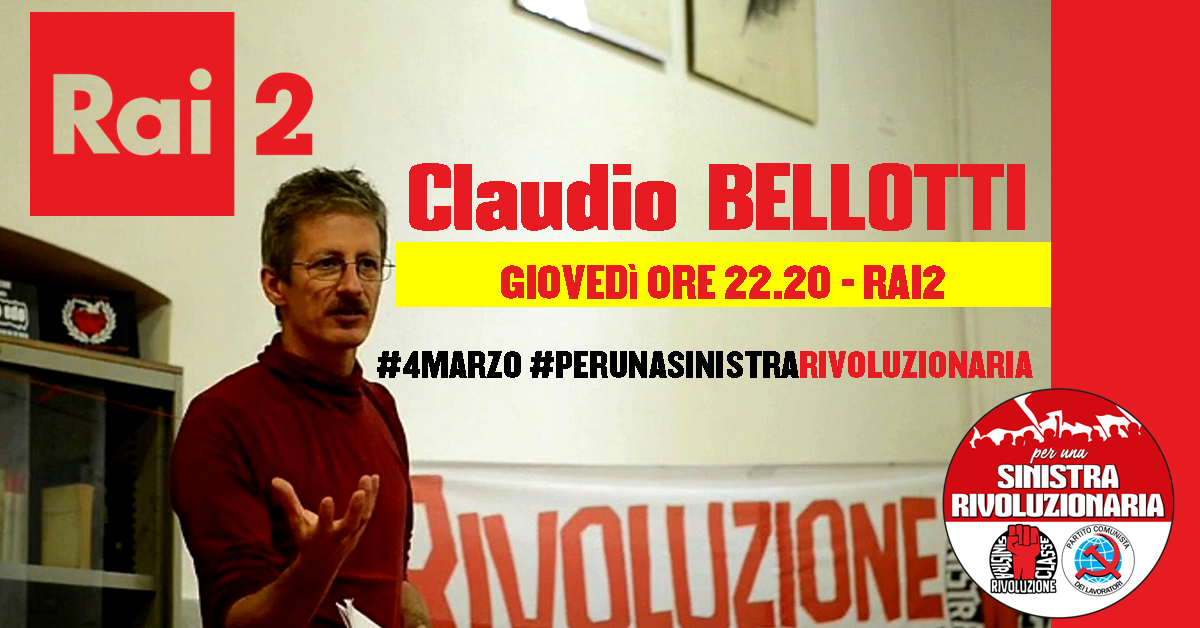 Claudio Bellotti, head of the list, communicated our entire programme over 40 minutes on the main national TV channel / Image: own work
Claudio Bellotti, head of the list, communicated our entire programme over 40 minutes on the main national TV channel / Image: own work
Worthy of merit is the appearance of Claudio Bellotti, head of the list, on the RAI2 main national TV channel on 22 February. Claudio was given 40 minutes to answer questions put to him by a panel of journalists. He was able to get across the whole programme of the Marxist Tendency, from the nationalisation of the banks and major industries, workers' control and management, a shorter working week, cancellation of the debt and for a Socialist Federation of Europe. He explained the need to take back the unions and for workers’ democracy, and much more. The programme started with clips of videos that showed the comrades outside factories, speaking to workers, the public meetings of the Tendency, the comrades selling the paper on the streets. It has really served to raise the profile of the Tendency and boosted the morale of all those comrades who for weeks were out on the streets almost every day collecting signatures.
Future perspectives
The comrades of the IMT in Italy have not abandoned their understanding of the connection between the working class and the mass organisations. The point that has to be understood about the Italian situation today is that – apart from the trade unions, where the Italian IMT has a significant presence, particularly in the FIOM metalworkers’ union, and also with a presence on leading bodies of the CGIL, including its national committee – there is no mass party of the working class.
The Italian working class, over a period of 30 years has seen its traditional party, the biggest Communist Party in Western Europe, destroyed. And nothing has emerged in its place. What there was to the left of the Democratic Party has collapsed. This has left an important layer with a feeling that they have no one to vote for. They hate the right wing of Berlusconi/Salvini, they detest Renzi’s Democratic Party, they can see the limitations of the M5S and they have not much faith in lists such as Power to the People.
In this situation, having an independent electoral list gives the Marxists an instrument with which to contact these layers and win them to Marxism. The future party of the Italian workers is not going to emerge from our small list. Major events will reshape the political scenario in Italy. Included among these will be a government involving the M5S, at a certain stage, which will prepare the ground for developments on the left.
In Europe we have seen the radicalisation of the working class and youth expressed in a variety of ways. In Britain it found its expression through Corbyn inside the traditional party of the British working class; in Spain it has found a partial expression in the rise of Podemos; in France it is gathering around Melenchon’s France Insoumise movement; earlier in Greece it was expressed through Syriza. What will happen in Italy? No one has a crystal ball that allows us to look into the future and see exactly how events will pan out. But the immense anger of the Italian working class at some point will find a political expression in one way or another. When that happens, the Marxists must be ready. And being ready does not mean simply having the correct programme, analysis and perspectives. It means being stronger as a force. This election campaign can be an important step in building up that force.
